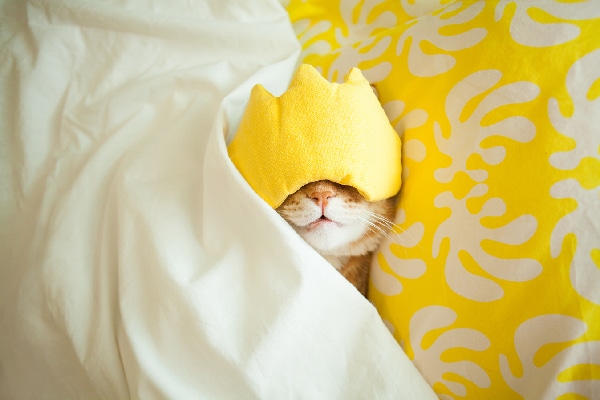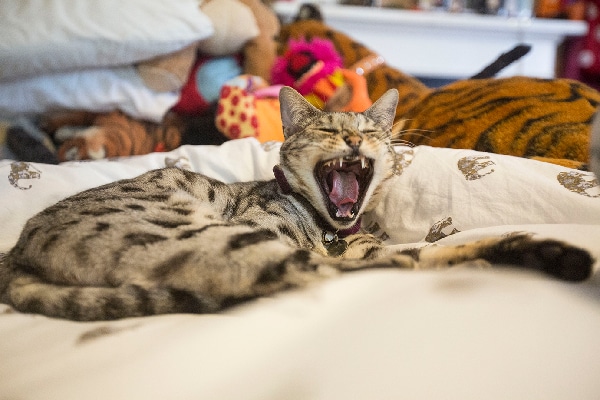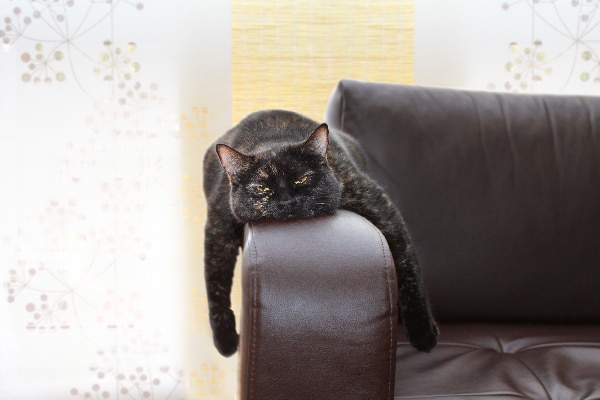Well, they don’t call it a dog nap! Cat nap is a ubiquitous term believed to have been coined in the 1880s. It’s basically a short nap during the day. The concept of napping seems to go back to Ancient Egypt. Since cats were considered sacred animals, the Pharaohs took a cue from the oft-slumbering felines and started sleeping for short spurts themselves throughout the day. Frequent sleep is normal for a healthy cat. However, a cat sleeping too much could signal that your kitty is sick. So, what’s the difference between a normal, healthy sleeping cat and a lethargic cat? Let’s find out when your cat is practicing business-as-usual cat sleeping behavior and when he could be heading for medical trouble.
First, how long do cats typically sleep?

Even if you don’t have a lethargic cat and your cat is in fine physical shape, felines generally sleep between 15 to 20 hours per day. According to renowned cat expert, Pam Johnson-Bennett, a cat’s sleep-filled day is an evolutionary tactic. Since cats are predators who had to hunt for their food in the wild, they require a lot of energy stored up for all that stalking and chasing. Their sleep patterns might seem excessive compared to the rest of the animal kingdom, which is mainly comprised of grazers, foragers and scavengers (aka slackers)!
Another part of natural cat behavior that makes it seem like our cats sleep a lot? Their sleep patterns. To kitties, party time starts when the sun goes down. The technical term is crepuscular and it means that cats are programmed to become most active from dusk until dawn.
Do you have a lethargic cat … or a cat who just loves to sleep?
So, it’s true that cats sleep more hours than most animals and they’re most active when most people are sleeping. Taking both of these normal cat sleeping patterns into account, it can seem as though cats are always asleep. However, a lethargic cat may indicate that something is wrong. Lethargy could signal a mild, passing condition — or a serious cause for alarm.
A solid way to find out if you’ve got a lethargic cat with serious issues on your hands? Try to play with your kitty. If he is uninterested in playing with his favorite toy, there could be a problem. One of my personal go-to moves when my cats seem “off” is to crunch the treat bag loudly. If they come running and take a treat, we’re good. But, when one of them does not, it’s investigation time. Knowing what’s “normal” for your cat is the baseline for when it’s time to schedule a trip to the vet.
What are the possible causes of a lethargic cat?

There could be a variety of things at play with a lethargic cat. Something as innocuous as a spike in the temperatures outside could make a cat nap in a cool place a bit longer. Or a cold spell could certainly entice Mr. Fluffkins to hibernate deep under the covers for longer than usual. However, the range of causes for a lethargic cat require a thorough investigation.
The Animal Wellness Center cites the following as possible reasons for a lethargic cat:
- Anemia
- Arthritis
- Cancer
- Depression
- Dehydration
- Heat stroke
- Heart Disease
- Heartworm
- Infections
- Kidney Disease
- Parasites
- Poison (Ingesting Foreign Object)
The most important thing you can do for a lethargic cat is to get him to the veterinarian. Lethargy is one of the 11 symptoms of a medical cat health emergency!
Have a lethargic cat who’s otherwise healthy on your hands?
If you’ve got a lethargic cat and you’ve taken him to the vet and ruled out serious medical possibilities — it’s time to address his environment. A poor diet doesn’t just result in a dull-coated, overweight (or underweight) cat. It also contributes to a lackluster approach to life. There are many delicious and nutritious feline diets available to get your cat to maximum physical condition. And, ensure there’s a lot of fresh water available at all times.
Next up, make sure there’s plenty of playtime in his world. Cats, like most mammals, need play throughout their lives. And, cats have certain cat toys that they consider fun. From feather toys to laser pointers to battery-operated mice, find out what gets your cat going and go for it!
In addition, making sure he’s got heights to scale (cat trees!) and places to hide are all part of an enriched environment for any cat family. Other elements like catios and cat climbing systems will also engage your lethargic cat in more meaningful, activity-driven ways.
The bottom line on a lethargic cat
Paying attention to your cat’s behavior is imperative to having a healthy and happy cat, and nothing is more important than determining if you have a lethargic cat on your hands. The difference between normal behavior and a dangerous condition quickly depends on you.
Feeling lethargic or low energy yourself? Could it be these three nutritional deficiencies? >>
Thumbnail: Photography © liveostockimages | iStock / Getty Images Plus.








